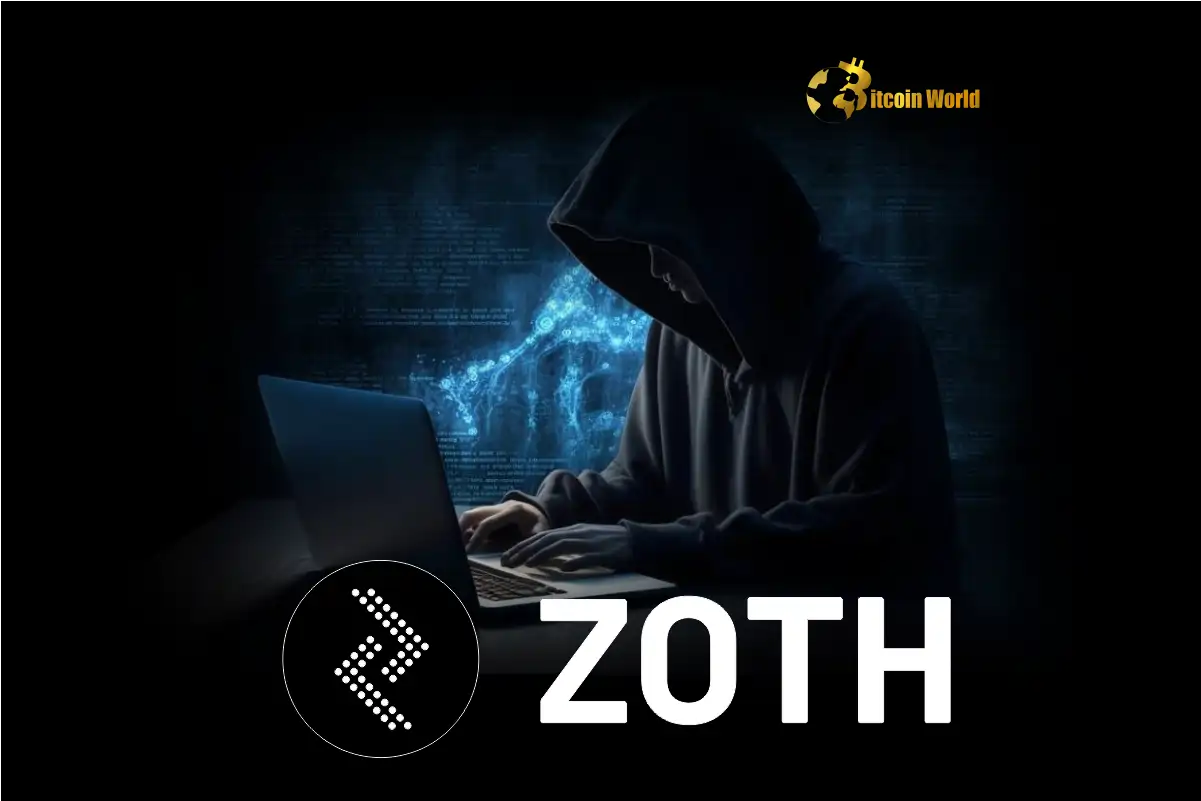Alarming Crypto Heist: Zoth Hacker Drains 1000 ETH, Converts to BTC and LTC
0
0

In a shocking turn of events in the decentralized finance (DeFi) space, a hacker associated with the infrastructure firm Zoth has reportedly siphoned off a substantial sum of cryptocurrency. Blockchain security firm PeckShield alerted the crypto community via X (formerly Twitter) about the movement of 1000 ETH, valued at approximately $1.5 million, from an address linked to the Zoth hacker. The stolen Ethereum was then routed through THORChain, a decentralized cross-chain liquidity protocol, before being converted into Bitcoin (BTC) and Litecoin (LTC). This incident throws a spotlight on the ever-present vulnerabilities within the DeFi ecosystem and the sophisticated tactics employed by crypto criminals.
Unpacking the DeFi Hack and the Crypto Trail
The initial report from PeckShieldAlert paints a concerning picture. Let’s break down what we know about this apparent DeFi hack:
- Source of Funds: An address identified as belonging to the Zoth hacker was the origin of the 1000 ETH. This suggests a direct compromise of Zoth’s infrastructure, though details about the nature of the breach remain scarce.
- Transaction Route: The hacker strategically utilized THORChain. This decentralized exchange (DEX) is known for its cross-chain capabilities, allowing for seamless swaps between different cryptocurrencies, including Ethereum, Bitcoin, and Litecoin.
- Conversion to BTC and LTC: The stolen ETH was ultimately converted into Bitcoin and Litecoin. This move could be an attempt to obfuscate the trail of funds, as Bitcoin and Litecoin, while traceable on their respective blockchains, have different ecosystems and transaction patterns compared to Ethereum.
Why ETH to BTC Swap? Decoding the Hacker’s Strategy
The decision to convert ETH to BTC and LTC raises several questions about the hacker’s motives and strategy. Why not keep the funds in ETH? Let’s consider some potential reasons:
- Liquidity and Anonymity: Bitcoin and Litecoin are among the most liquid cryptocurrencies. Swapping to these more established assets provides greater flexibility for further transactions and potentially easier avenues for cashing out, although exchanges are increasingly implementing KYC/AML regulations. Furthermore, while all blockchain transactions are traceable, moving funds across different chains and into different asset types can add layers of complexity for investigators.
- Diversification of Risk: It’s possible the hacker is diversifying their holdings. By spreading the stolen funds across multiple cryptocurrencies, they might be aiming to reduce the risk associated with holding a large amount of a single asset, especially one that is being actively tracked.
- Anticipating Asset Movements: There could be strategic reasons related to market movements. Perhaps the hacker anticipates Bitcoin and Litecoin to appreciate in value more than Ethereum in the short term, though this is speculative and less likely the primary driver compared to obfuscation and liquidity.
The Growing Threat of Crypto Theft in DeFi
This latest incident serves as a stark reminder of the ongoing challenges in blockchain security, particularly within the rapidly evolving DeFi sector. DeFi platforms, while promising greater financial accessibility and innovation, are often targeted due to the large sums of value locked within smart contracts and protocols. The decentralized and often permissionless nature of DeFi also presents unique security hurdles.
Key Challenges in DeFi Security:
| Challenge | Description | Impact |
|---|---|---|
| Smart Contract Vulnerabilities | Bugs or flaws in the code of smart contracts that govern DeFi protocols. | Exploitation can lead to direct theft of funds, manipulation of protocol logic. |
| Oracle Manipulation | DeFi protocols often rely on oracles to provide external data (e.g., asset prices). If oracles are compromised, protocols can be manipulated. | Incorrect data feeds can trigger unintended contract executions, leading to financial losses. |
| Flash Loan Attacks | Exploiting flash loans (uncollateralized loans taken and repaid within the same transaction) to manipulate market prices or protocol states. | Allows attackers to execute complex attacks with minimal upfront capital. |
| Rug Pulls & Exit Scams | Malicious project developers absconding with user funds. | Significant financial losses for users, damages trust in the DeFi space. |
| Private Key Compromise | If private keys controlling wallets or smart contracts are compromised, attackers gain full control of the associated assets. | Direct access to and theft of funds. |
Actionable Insights: What Can the Crypto Community Learn?
The Zoth crypto theft and subsequent ETH to BTC and LTC swap offer several crucial lessons for the crypto community:
- Enhanced Security Audits: DeFi projects must prioritize rigorous and frequent security audits of their smart contracts and infrastructure. Independent audits by reputable firms are essential to identify and mitigate potential vulnerabilities.
- Proactive Monitoring and Threat Detection: Real-time monitoring of on-chain transactions and anomaly detection systems are crucial for identifying and responding to suspicious activities quickly. Platforms like PeckShieldAlert play a vital role in this.
- User Education and Awareness: Crypto users need to be educated about the risks associated with DeFi and best practices for security, such as using hardware wallets, being cautious about interacting with unaudited protocols, and understanding the risks of different DeFi platforms.
- Cross-Chain Security Considerations: As cross-chain protocols like THORChain become more prevalent, security measures must extend across multiple blockchains to prevent exploits that leverage inter-chain vulnerabilities.
- Collaboration and Information Sharing: The crypto community needs to foster greater collaboration and information sharing regarding security threats and incidents. Open communication and coordinated responses can help to mitigate damage and prevent future attacks.
Conclusion: A Wake-Up Call for DeFi Security
The Zoth hacker incident, involving the theft of 1000 ETH and its conversion to BTC and LTC, is a stark reminder of the ongoing security challenges in the DeFi space. While the decentralized and innovative nature of DeFi offers immense potential, it also presents a fertile ground for sophisticated cybercriminals. Strengthening security measures, promoting user education, and fostering community collaboration are paramount to building a more resilient and trustworthy DeFi ecosystem. The industry must learn from these alarming events and proactively address vulnerabilities to safeguard the future of decentralized finance.
To learn more about the latest crypto market trends, explore our article on key developments shaping Ethereum price action.
0
0
 Manage all your crypto, NFT and DeFi from one place
Manage all your crypto, NFT and DeFi from one placeSecurely connect the portfolio you’re using to start.








